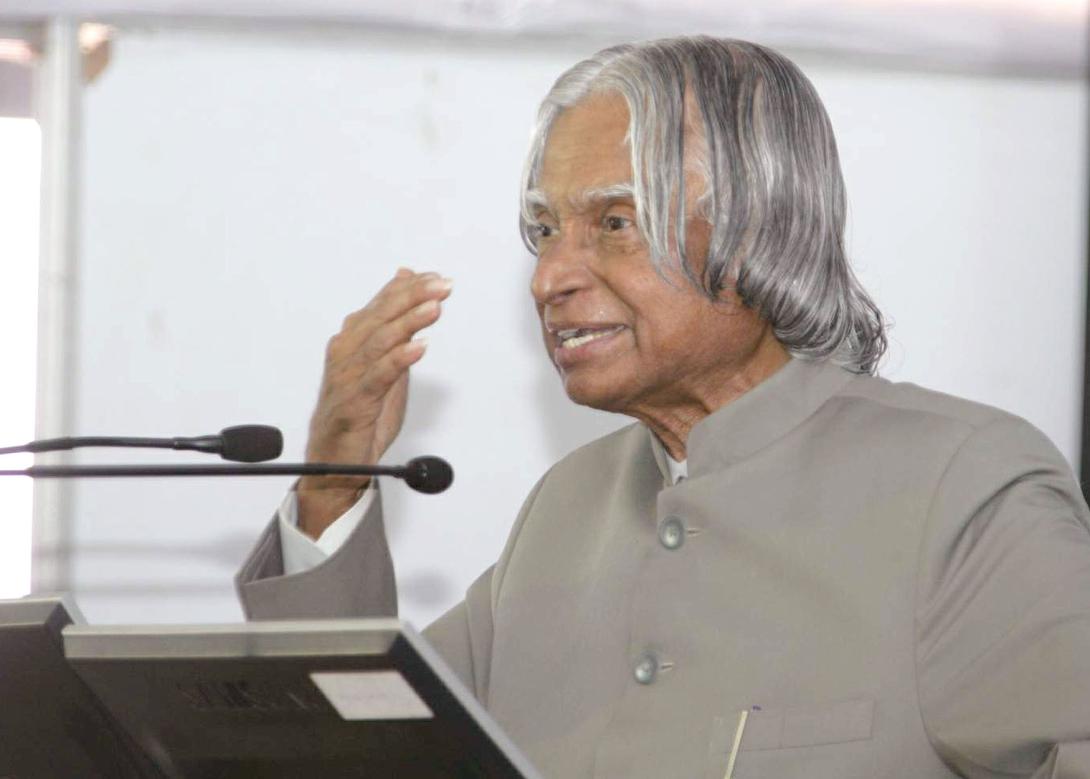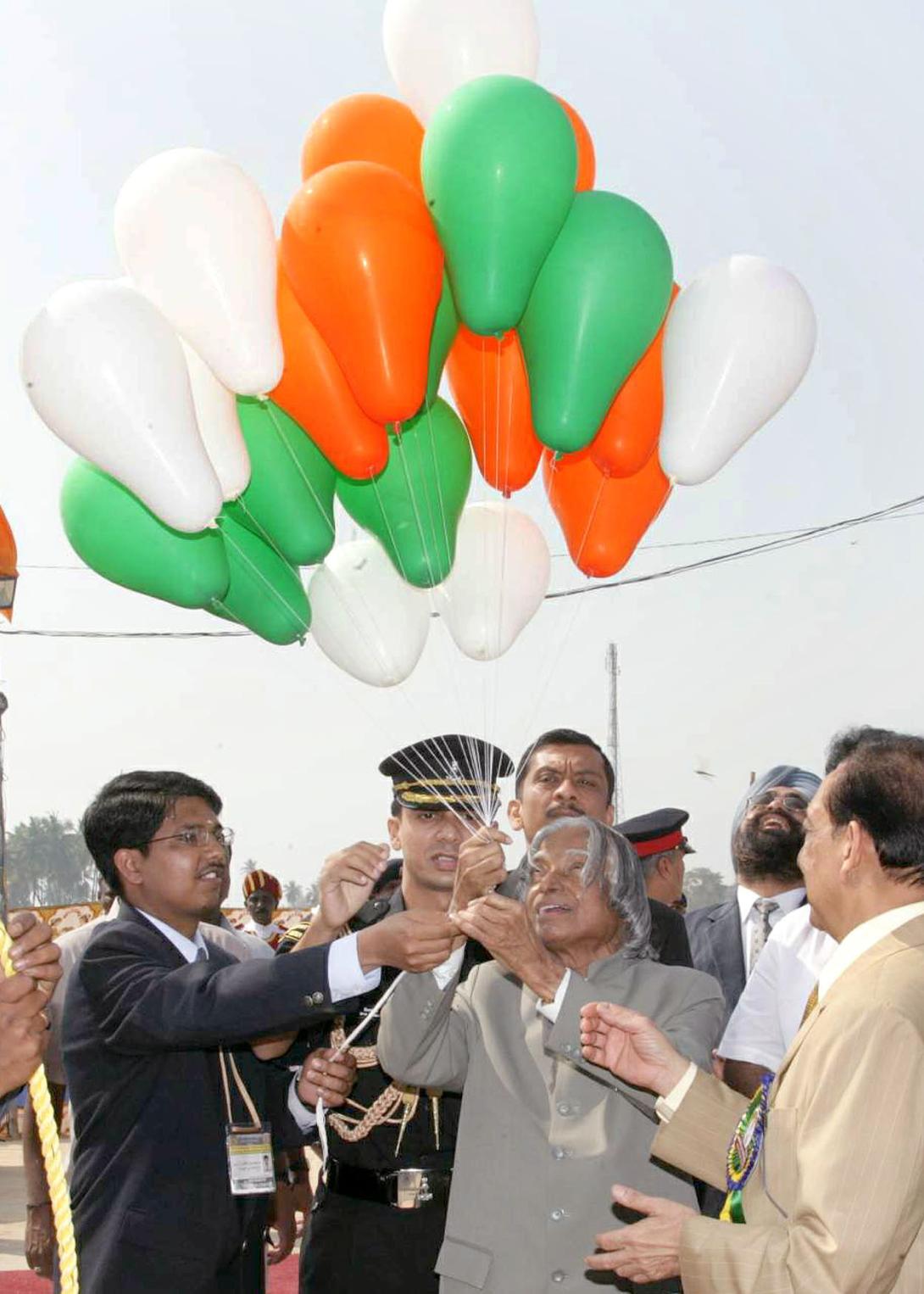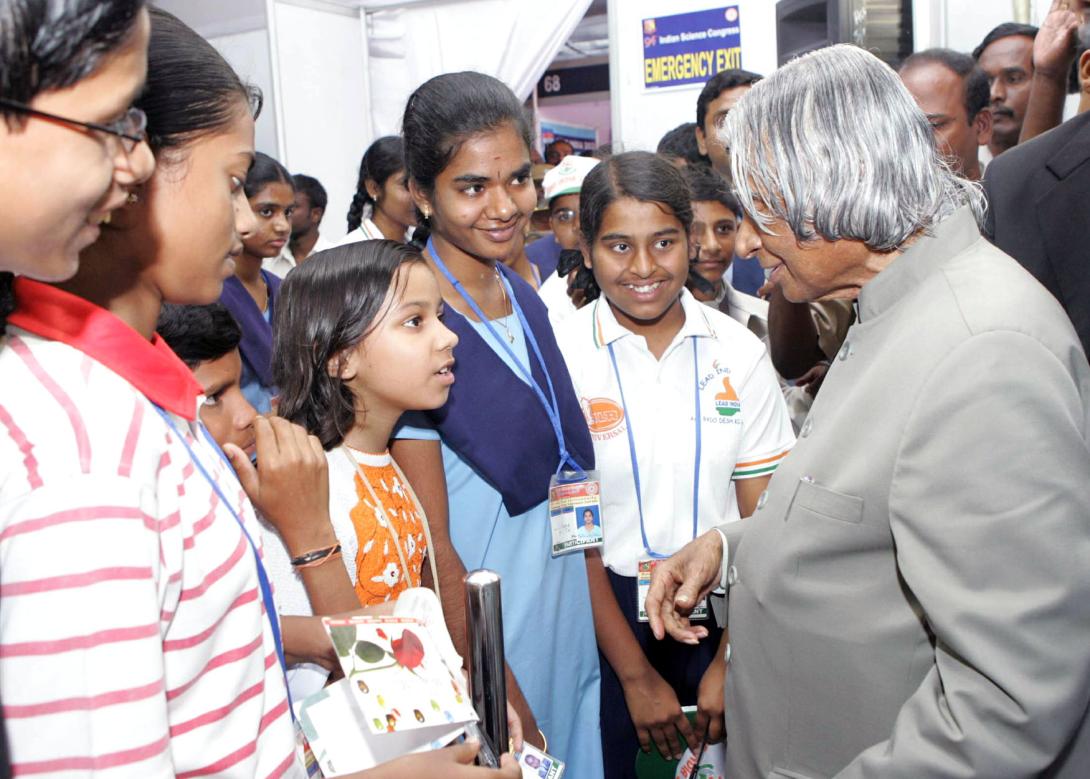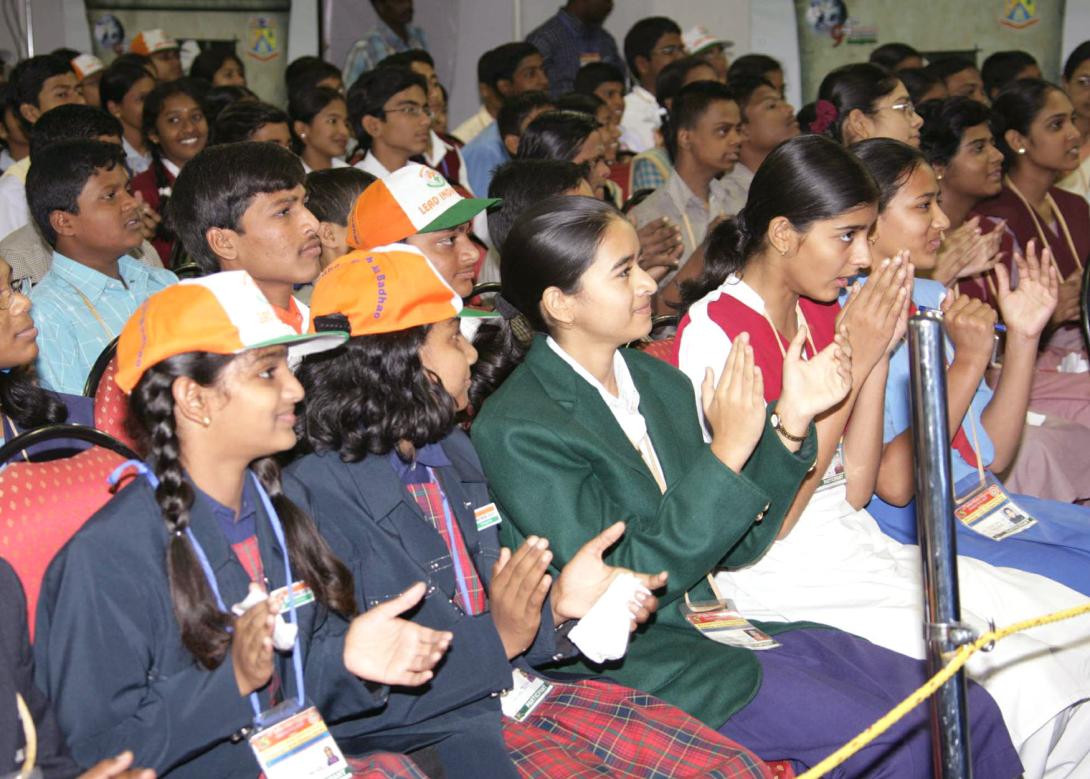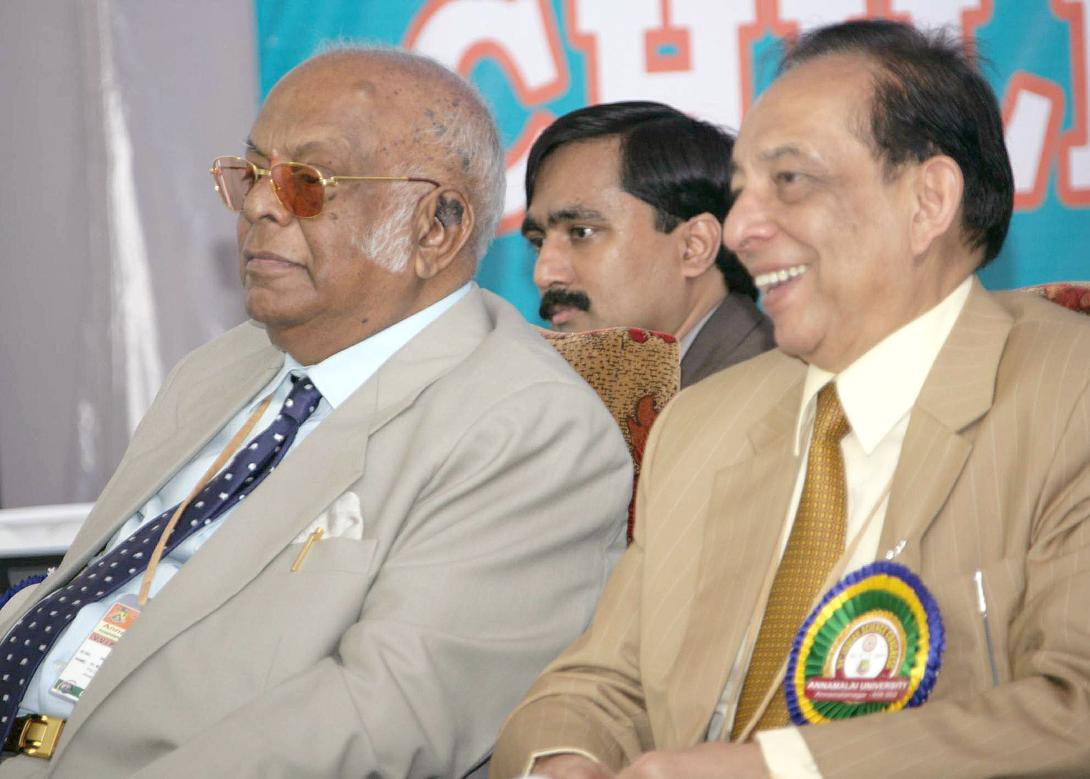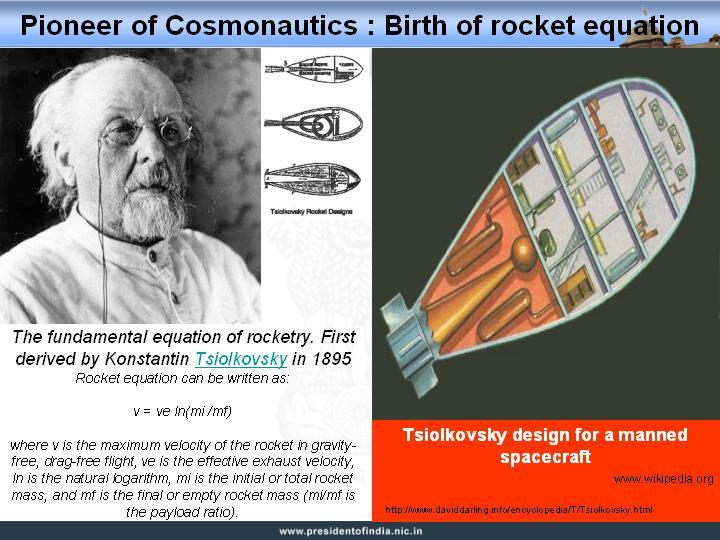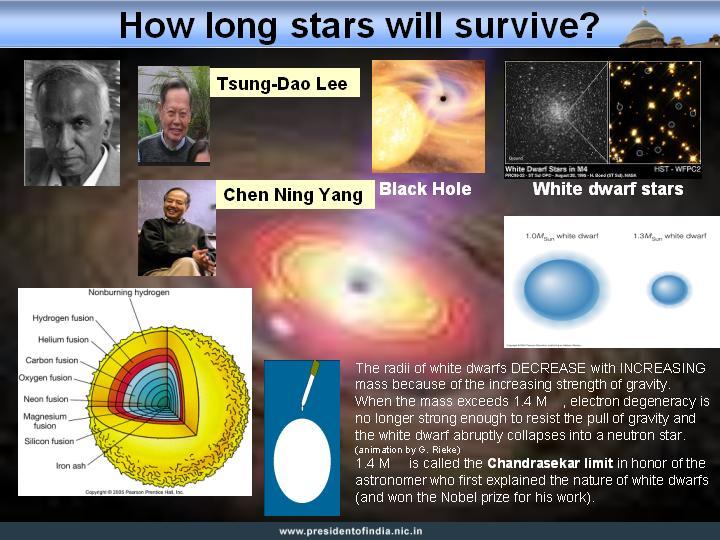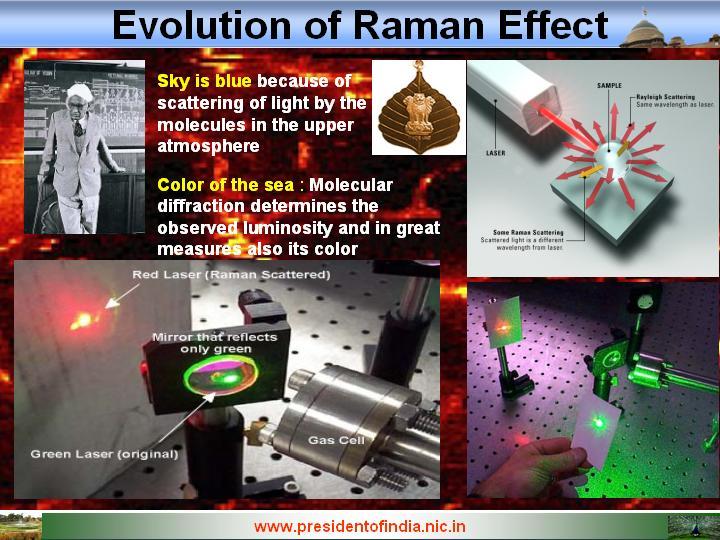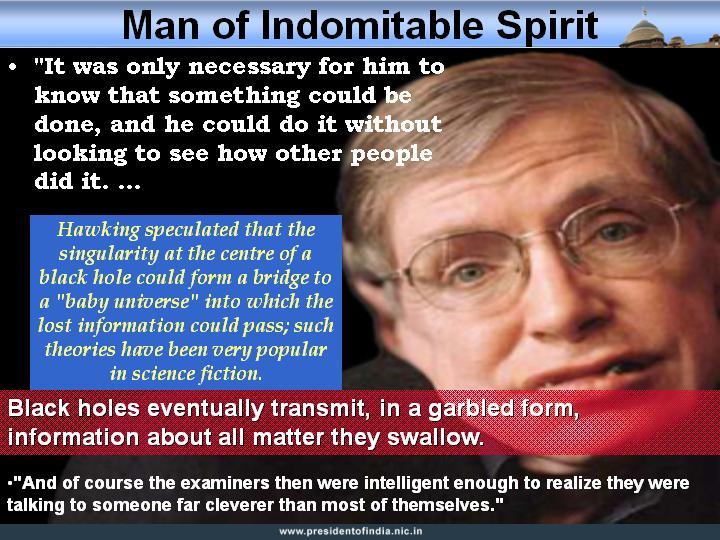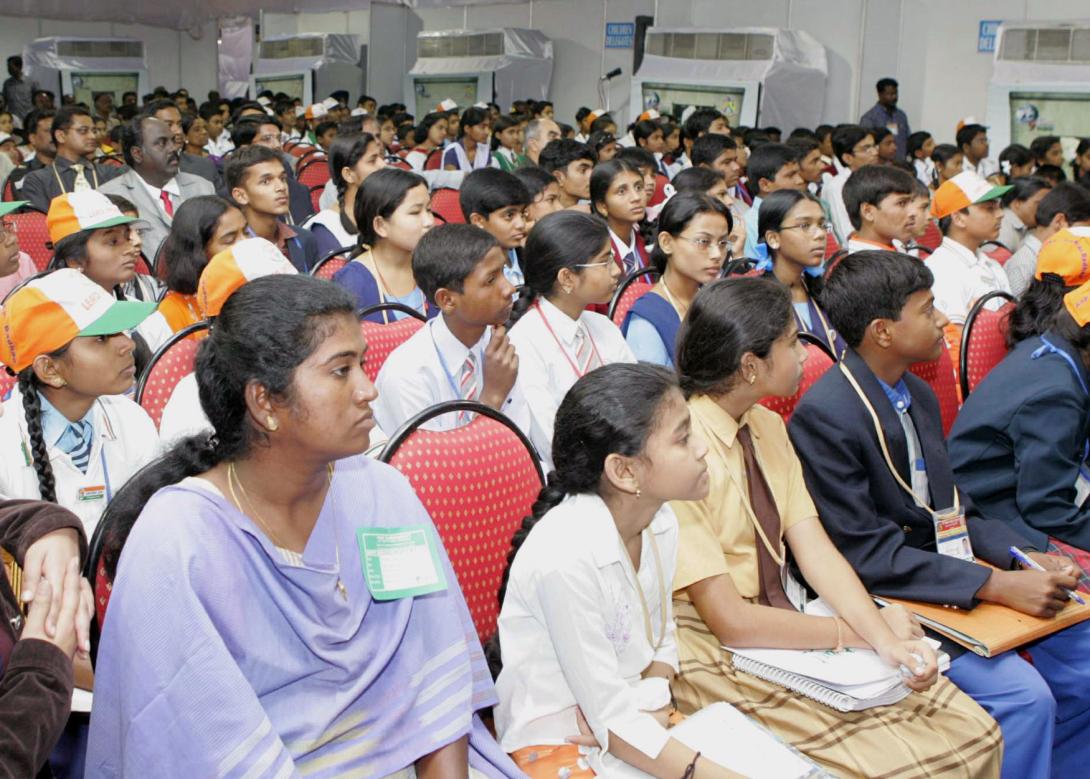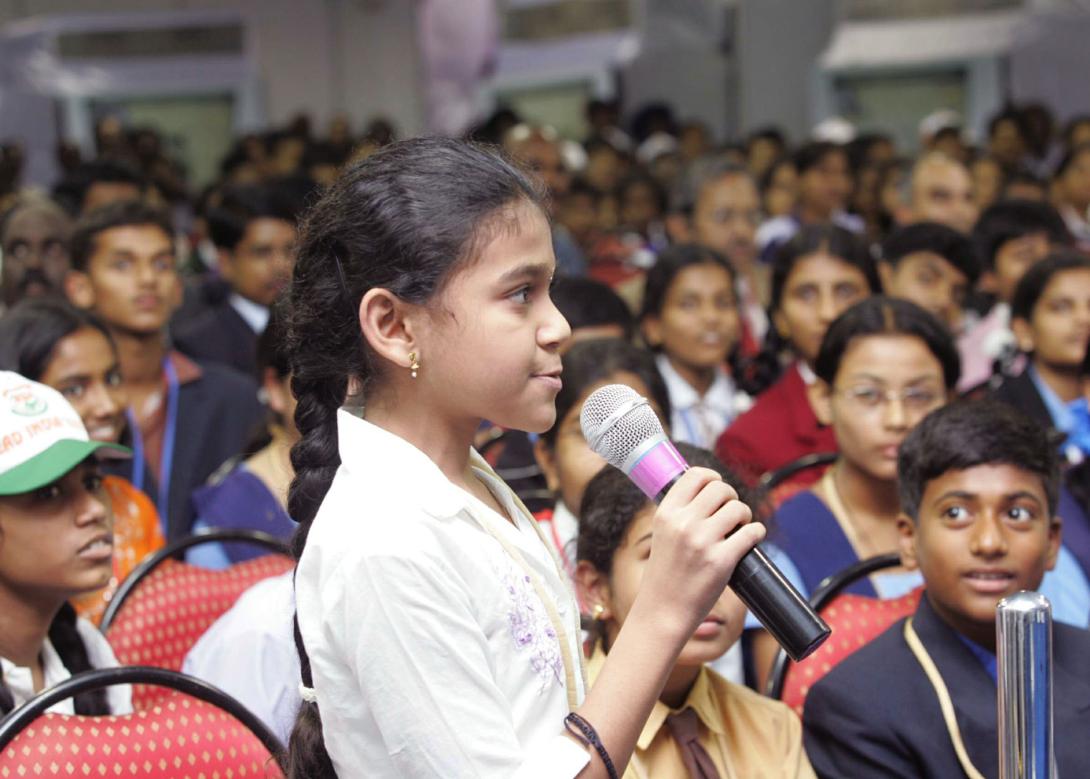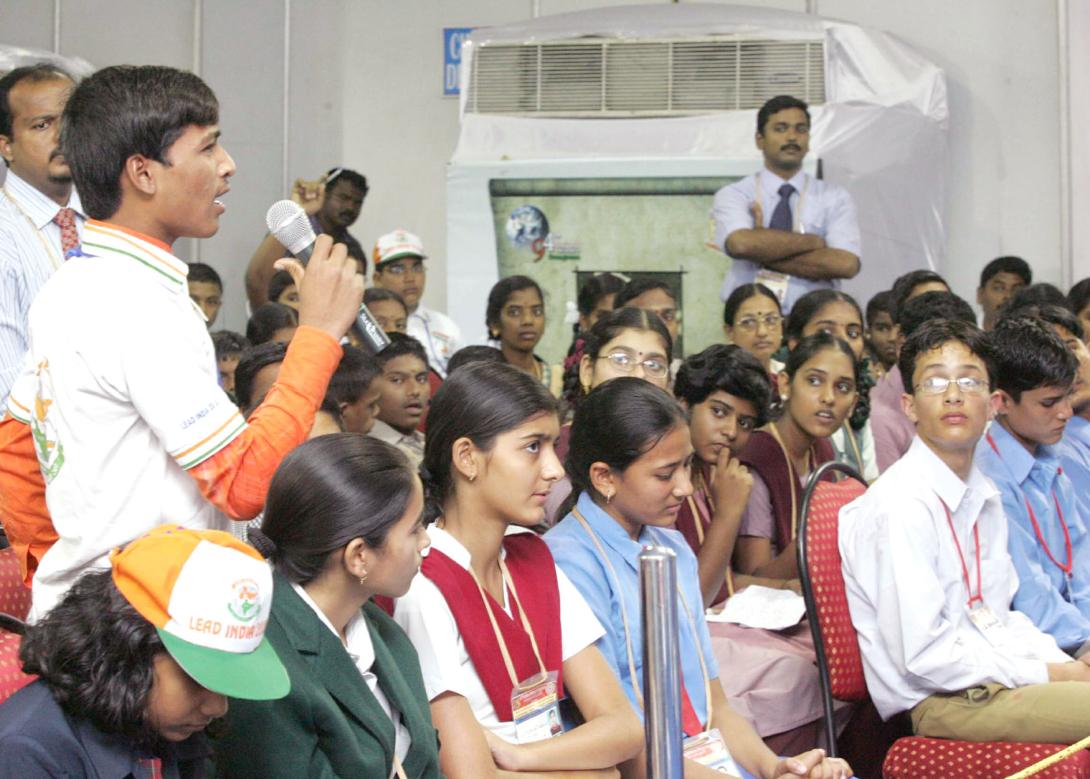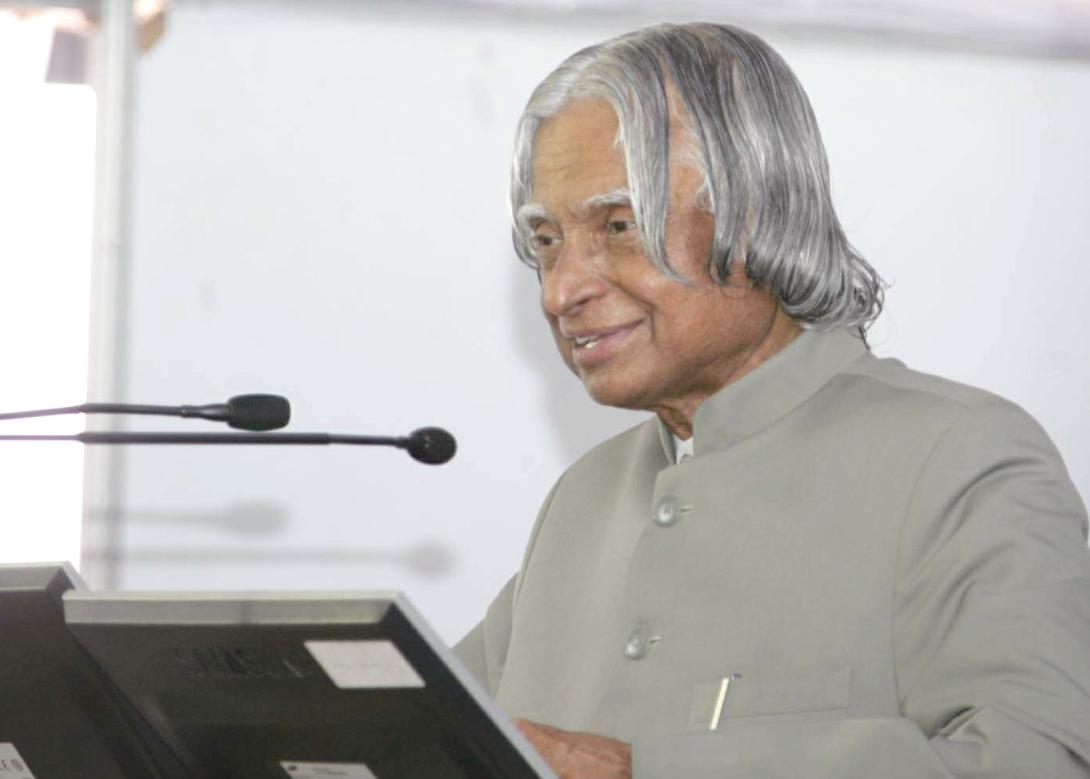Address at the Inauguration of Children's Science Congress, Chidambaram, Tamil Nadu
Chidambaram, Tamil Nadu : 05-01-2007
Inspirational Scientific Leaders
"Atmosphere is the life supporting heritage
for living systems of planet Earth"
I am indeed delighted to participate in the inauguration of the Children's Science Congress organized as part of 94th Indian Science Congress. My greetings to the organizers, students, teachers and science planners participating in this Congress.
Dear young friends, within two weeks time, I have addressed the State Level Children?s Science Congress in Tamilnadu and National Children?s Science Congress in Sikkim, and today I am addressing Children Science Congress which is the part of 94th Indian Science Congress. Many of you participating today might have attended the previous events also. I greet all of you.
What thoughts I can share with you? Shall I talk to you on man?s mission to mars and creation of beautiful human civilization in next 100 years in other planets; Shall I talk to you on the evolution of a disease free human life through the characterization of all the 30,000 genes, or shall I talk to you how science in India will enter into a new phase in another three decades leading to energy generation through fusion, and large scale production of renewable sources leading to energy independence. No I am not going to talk to you on any one of these subjects. I realize you are in the age group of 10-17 years. More than sixty years are waiting in front of you, which will bring difference to the planet earth. I thought what you need is the understanding of the young lives who later became great scientific and mathematical minds which has made a difference to the planet earth in the 19th and 20th century. I have selected the life of five great scientific thinkers.
Life of great scientific thinkers
Konstantin Tsiolkovsky who gave to the world a rocket equation that led to space technology, hence man is in a position today to explore other planets; Chandrasekhar Subramanyan ? gave astrophysical Chandrasekhar limit that led to the estimation of stars life, particularly our sun and thereby predicting the life of planet earth; Sir CV Raman ? who discovered the Raman effect which explains the inelastic scattering of a photon. Recently, Intel researchers have disclosed the development of the first continuous wave all-silicon laser using the Raman Effect. A low-cost all-silicon Raman laser could inspire innovation in the development of new medical sensors, and spectroscopy devices. Einstein gave the famous energy equation to the world; Finally Stephen Hawking who found out the ability of the black holes to provide information on all the matter they swallow and he has explained more details in his recent book ?The theory of everything?.
Pioneer of Cosmonautics : Birth of rocket equation
Now I would like to discuss about Konstantin Eduardovich Tsiolkovsky a Russian rocket scientist and a pioneer of cosmonautics. As a child, Konstantin caught scarlet fever and became hard of hearing. He was not accepted at elementary schools because of his hearing problem, so he was home schooled until the age of 16 by his mother. Nearly deaf, he worked as a high school mathematics teacher until retiring in 1920. Tsiolkovsky theorized many aspects of space travel and rocket propulsion. He is considered the father of human space flight and the first man to conceive the space elevator, after visiting Paris in 1895 and becoming inspired by the newly-constructed Eiffel Tower. Tsiolkovsky calculated that the speed required to orbit the Earth is 8 km/second and that this could be achieved by means of a multi-stage rocket fueled by liquid oxygen and liquid hydrogen. Among his works are designs for rockets with steering thrusters, multi-stage boosters, space stations, airlocks for exiting a spaceship into the vacuum of space, and closed cycle biological systems to provide food and oxygen for space colonies. His work influenced later rocketeers throughout Europe, and was also studied by the Americans. The basic equation for rocket propulsion, the Tsiolkovsky rocket equation, is named after him. This equation is used to estimate how much escape velocity needed for interplanetary travels. He believed that colonizing space would lead to the perfection of the human race, with immortality and a carefree existence. He said, ?The Earth is the cradle of mankind, but one can not eternally live in a cradle!". "Men are weak now, and yet they transform the Earth?s surface. In millions of years their might will increase to the extent that they will change the surface of the Earth, its oceans, the atmosphere and themselves. They will control the climate and the solar system just as they control the Earth. They will travel beyond the limits of our planetary system; they will reach other Suns and use their fresh energy instead of the energy of their dying luminary." "Man must at all costs overcome the Earth's gravity and have, in reserve, the space at least of the Solar System." This is a great message for young scientists to research.
Let me now describe how the reading habit of a person, his love for mathematics and his ability to sense the changing situation creates a great scientific leader.
Chandrasekhar Subramanyan : How long stars will survive?
Chandrasekhar in his younger days mastered mathematics and German. His uncle C. Ramasamy says ?Chandrasekhar?s performance at School, especially in Mathematics, was at least 3 years ahead of the class. His classmates were aware of his potentialities and recognized that he was a genius among them.? He was a voracious reader and has read everything from Shakespeare to Hardy. His reading speed was up to 100 pages in an hour. This speed helped him to read all the scientific journals, while he was in college and understand the research that was going on in the laboratories in the world. While he was studying in the Presidency college, Sommerfield gave a lecture on the exciting new developments in physics. Chandra was the one individual in that audience who followed every word that the great master uttered. After the lecture, Chandra had some very useful discussion with Sommerfield. Later after his degree, he went to Trinity. During his tenure at Trinity, he presented two papers to the Royal Astronomical Society. One of these presentations dealt with the theory of white dwarf stars and how the quantum mechanical properties of the electron dictate the behavior of these stars at the end of their life cycle. Chandrasekhar's colleague Eddington followed this paper with a presentation that was very critical of Chandrasekhar's results. This attack was severe blow to Chandrasekhar's feeling and left a life long impression on him. As a result of the disagreement and the stature of Sir Arthur Eddington, Chandrasekhar accepted a position as a research associate at the University of Chicago offered to him by the famous American astronomer Otto Struve. Chandrasekhar stayed at University of Chicago throughout his career.
Chandrasekhar's most famous success was the astrophysical Chandrasekhar limit. The limit describes the maximum mass (~1.44 solar masses) of a white dwarf star, or equivalently, the minimum mass for which a star will ultimately collapse into a neutron star or black hole following a supernova. The limit was first calculated by Chandrasekhar while on a ship from India to Cambridge, England.
Two of Chandrasekhar's students in 1947 were the doctoral candidates Tsung-Dao Lee and Chen Ning Yang from China. Even though he maintained his office at the Yerkes Observatory In Lake Geneva, Wisconsin, he would regularly drive the one hundred miles to Chicago to instruct Lee and Yang. In 1957, these two students won the Nobel prize in Physics for their work in particle physics research. This shows Chandrasekhar?s dedication and commitment to his students. In 1999, NASA named the third of its four "Great Observatories'" after Chandrasekhar. Now, I would like to present how an enquiring mind of careful observation leads to path breaking result in science.
Sir C.V. Raman : Evolution of Raman Effect
Why is the sea blue? The view has been expressed that the dark blue of the deep sea has nothing to do with the color of water. It is simply the blue of the sky seen by reflection. Sir CV Raman then questions this view describing his own experiment on board the ship: Observations made in this way in the deeper waters of Mediterranean and Red sea showed that the color so far, from being impoverished by suppression of sky reflection was wonderfully improved here by. It was abundantly clear from the observation that the blue color of the deep sea is a distinct phenomenon itself and not merely an effect due to reflected sky light. Later Raman draws attention to the connection between the color of deep waters and the Einstein Smoluchowski formula. Naturally he starts with that the sky is blue because of scattering of light by the molecules in the upper atmosphere. The color of the sea is a different matter. Rayleigh believes it was all due to reflection, but Raman gives an entirely different view, that in this phenomenon, as in the parallel case of the color of sky, molecular diffraction determines the observed luminosity and in great measures also its color. This led to the birth of the Raman Effect. Since I am in the midst of children Scientists, I thought of sharing with you an incident narrated in the book about Sir CV Raman. Raman was in the first batch of Bharat Ratna Award winners. The award ceremony was to take place in the last week of January, soon after the Republic Day celebrations of 1954. The then President Dr. Rajendra Prasad wrote to Raman inviting him to be the personal guest in the Rashtrapati Bhavan during his visit to Delhi for the award ceremony. He wrote a polite letter, regretting his inability to participate in the award ceremony. Raman had a noble reason for his inability to attend the investiture ceremony. He explained to the President that he was guiding a Ph.D. student and that thesis was positively due by the last day of January. The student was valiantly trying to wrap it all up and Raman felt, he had to be by the side of the research student, see that the thesis was finished, sign the thesis as the guide and then have it submitted. Here was a scientist who gave up the pomp of a glittering ceremony associated with the highest honour, because he felt that his duty required him to be by the side of the student. It is this character that truly builds science. These characteristics are portrayed very lucidly in the book titled ?The Big and the Small? from the Microcosm to the Macrocosm written by Dr. G. Venkataraman?.
Albert Einstein and Energy Equation
Now let us study how great scientists like Albert Einstein got shaped for science in their school days.
Teachers' influence: In Albert Einstein life, we find that his interest in science started early, beginning with his encounter with magnetism, which he called ?the first miracle?. He was given a compass by his father and Einstein was endlessly fascinated by the fact that invisible forces could make object move. This experience made a lasting impression on him. His interest in compasses was reinforced when he found a caring mentor to hone his ideas. At the age of 12, he experienced second wonder in a little book given by his mentor Max Talmud with Euclidean plain Geometry which he called ?Holy Geometry Book?. Einstein called this his ?second miracle?. Here Einstein made contact with the realm of pure thought. Without expensive laboratories or equipment, he could explore universal truth, limited only by the power of human mind. Mathematics became an endless source of pleasure to Einstein especially if intriguing puzzle and mysteries were involved.
Visualizing pictures: Einstein?s father was in an electro chemical business. Being in the midst of electro magnetic contraptions awakened an intuitive understanding of electricity and magnetism in Albert Einstein. It sharpens his ability to develop graphic, physical pictures that would describe the laws of nature with uncanny accuracy. This trait, the ability to see everything in terms of physical pictures, would mark one of Einstein?s great characteristics as a physicist.
Freedom to Learn: Though born in Germany, Einstein moved to Zurich Polytechnic Institute in Switzerland. The entry into the polytechnic did not require a high school diploma, just a passing grade on its tough entrance examination was sufficient. Einstein failed in the entrance examination but he did exceptionally well in the Maths and Physics section. That impressed the Principal and he promised to take him during the following year without an entrance test and the Principal did it. The message we get from this experience is about having a flexible system of admission. Also an ability to spot the aptitude of the student in a particular subject and nourishing the talents. In addition, Einstein enjoyed the liberal atmosphere of the Swiss school.
Simplicity in description: Unlike other scientists who often got lost in Mathematics, Einstein got in terms of simple physical picture ? speeding trains, falling elevators, rockets and moving clocks. These pictures would unerringly guide him through the greatest ideas of the twentieth century. He wrote ?All physical theories, their mathematical expression notwithstanding, ought to lend themselves to so simple a description that even a child could understand?. This is a very important message for all physics researchers and physics teachers. Here the birth of famous simple, elegant and very powerful energy equation E=MC2, which decided war and peace system of the world.
Stephen Hawking : Man of Indomitable Spirit
Stephen Hawking joined the University College, Oxford with the intent of studying mathematics, but after his first year changed his concentration to physics. His physics tutor, Robert Berman, later said in the New York Times Magazine, "It was only necessary for him to know that something could be done, and he could do it without looking to see how other people did it. ... He didn't have very many books, and he didn't take notes. Of course, his mind was completely different from all of his contemporaries." He was popular with his fellow students, but his unimpressive study habits gave him a final examination score on the borderline between first and second class honors, making an oral examination necessary. Berman said of the oral examination, "And of course the examiners then were intelligent enough to realize they were talking to someone far cleverer than most of themselves."
After completing his B.A. at Oxford in 1962, he studied astronomy and decided to leave when he found that studying sunspots through an observatory didn't appeal to him and that he was more interested in theory than in observation. He left Oxford for Trinity Hall, Cambridge, where he engaged in the study of theoretical astronomy and cosmology.
Almost as soon as he arrived at Cambridge, he was struck by the motor neuron disease which would cost him the loss of almost all neuromuscular control. During his first two years at Cambridge, he did not distinguish himself, but, after the disease had stabilized and with the help of his doctoral tutor, Dennis William Sciama, he returned to working on his Ph.D. Hawking later said that the real turning point was his 1965 marriage to Jane Wilde, a language student.
Hawking had earlier speculated that the singularity at the centre of a black hole could form a bridge to a "baby universe" into which the lost information could pass; such theories have been very popular in science fiction. But according to Hawking's new idea, presented at the 17th International Conference on General Relativity and Gravitation, on 21 July 2004 in Dublin, Ireland, black holes eventually transmit, in a garbled form, information about all matter they swallow. Stephen Hawking spoke in China and made the statement that humans might have already damaged the atmosphere and inadvertently reconnected the planet Earth with her dead neighbors.
When Hawking (then using a wheelchair and unable to dress himself) and his wife were first living together, they received no outside assistance other than from physics students who helped in exchange for extra attention with their work. As his condition worsened, Hawking needed a team of nurses to provide round-the-clock care. He also needed a wheelchair for mobility. Despite his disease, he describes himself as "lucky" ? not only has the slow progress of his disease provided time to make influential discoveries, it has also afforded time to have, in his own words, "a very attractive family". During a visit to the research center CERN in Geneva in 1985, Hawking contracted pneumonia, which in his condition was life-threatening. It resulted in acute difficulty of breathing, which could only be overcome through a tracheostomy by which Stephen Hawking lost his natural speech ability. He has since used an electronic voice synthesizer to communicate. The voice synthesizer, which has an American accent, is of a model that is no longer being produced. Efforts are on to replace with a newer synthesizer.
At this stage, with so much of natural and man made disasters facing planet Earth; let me share with you a thought from Stephen Hawking. He asked an open question in June 2006: "How can the human race survive the next hundred years?" When he received well over 20,000 mixed responses on e-mail, he admitted that he does not have an answer.
The young scientific minds assembled here have the responsibility to create conditions on planet Earth so that the human race can survive for centuries to come. That is the real answer.
Research Challenges
Let me share with you certain scientific challenges that need integrated solution to enrich the life of the people of our planet particularly our nation.
1. In the energy sector, increasing the solar photovoltaic cell efficiency from the existing 15% to 45% using silicon as a base with Carbon Nano Tube is an important research challenge. Scientists in reputed laboratory in the world have established the fact that the alignment of the CNT with the polymer composites substrate is the key issue and this aligned CNT based PV cells would give very high efficiency in photovoltaic conversion. The polymer composites increase contact area for better charge transfer and energy conversion. In this process, the researchers could achieve the efficiency of about 50% at the laboratory scale. The intensity of research in Indian research institutions have to be enhanced to realize commercial production of CNT based Photovoltaic cells.
2. India has to go for nuclear power generation in big way using thorium based reactor. Thorium, a non fissile material, is available in abundant in our country. Intensive research is essential for converting thorium for maximizing its utilization and generating electric power through thorium based reactors.
3. Proteomics is the study of all the proteins expressed by the genome of a cell. It is the logical extension of genomics. Proteomics helps to understand the basic biological processes critical to normal cellular functions as well as the development of diseases. It identifies the essential components of these processes and exploits these components as targets in the development of new methods to prevent or treat diseases. The proteomics programme is done nationally. The type of work involved is huge and challenging, and much bigger than the Human genome programme. There is national programme in proteomics. This has to be given thrust with cooperation of International Scientific community.
4. There are many research and development and testing of vaccine are progressing in the country for prevention of HIV/AIDS disease. It is indeed a big challenge for life science scientists to have an integrated vaccine development leading to production in three years time.
5. Stem cell research through three areas such as Adult stem cells, umbilical cord stem cells, and embryonic stem cells has to be pursued on a mission mode for finding cure for many diseases.
6. In many places in our planet, we experience severe earthquakes resulting in loss of life, loss of wealth and in some cases it destroys the decades of progress made by the country and its valuable civilizational heritage. India has earthquake problems periodically in certain regions. During my recent visit abroad, I found serious research in Iceland, Ukraine and Russia by young scientists. It is essential India has to work on mission mode research for forecast the earthquake using multiple parameters using precursors such as pre-shock conditions, electromagnetic phenomena prior to final rupture and atmospheric and ionospheric anomalies.
7. The quantum of rainfall in a particular area for a particular cloud condition within a specified duration is not being determined by the present monsoon prediction system. Recent heavy rains in Mumbai, Chennai, Hyderabad in our nation and Katrina hurricane in US has created enormous loss of life and property. This brings out the necessity for global monsoon research for determining intensity and quantum of rain in a particular cloud condition through a validated prediction system with detailed research. With this system scientists should be able to provide the information for the particular cloud condition, how much rain will come in what period through the use of Polorimetric radar.
I have given seven examples of problems that can challenge young scientists. There are many other challenges in other disciplines as well. What is required is to read, observe, question, hypothesize, model, experiment, synergise experience and find solutions. Validation of models, observations and solutions to sample populations and extending them universally is another big challenge. The findings of science have to be incorporated in engineering products through technology. Such a life time mission of a scientist involves quest, innovative spirit, learning, sweating and not getting beaten by problems.
Conclusion
Dear friends, science and technology will be an important ingredient to transform India into a developed nation before 2020. The young scientific minds assembled here which represent the 300 million youth of the nation of your age group, should develop the curiosity, knowledge, core competence, determination, perseverance and the courage to invent new phenomena in science and technology leading to path breaking discoveries for finding solutions to Indians problems.
Dear Friends, I would like to refer the following books for your study.
1. Chandrasekhar and His Limit by G. Venkataraman
2. The Theory of Everything ? The origin and fate of the universe by Stephen W. Hawking
3. Zero ? The Biography of a Dangerous idea by Charles Selfe
4. The Weather Makers - by Tim Flannery
5. Mission: Success! ? by O.G. Mandino
Now, I would like to administer the oath on courage.
Courage
Courage to think different,
Courage to invent,
Courage to travel into an unexplored path,
Courage to discover the impossible,
Courage to combat the problems and Succeed, are the unique qualities of the youth.
As a youth of my nation, I will work and work with courage to achieve success in scientific discoveries.
With these words, I inaugurate the Children?s Science Congress 2007 and my best wishes to all the participants from different States success in their mission of ?nurturing nature for our future through bio-diversity?.
May God bless you.

